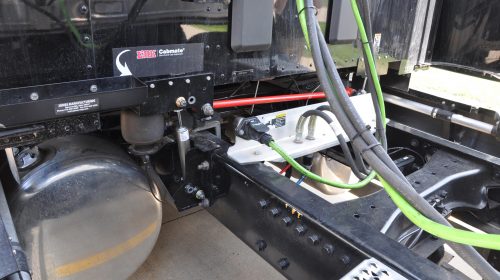The newest and most advanced version of the Link Mfg. Cabmate cab suspension, widely specified in on/off- and on-highway Class 8 trucks, features Road-Optimized Innovations (ROI) technology, imparting what product engineers call a new level of ride quality by responding to road and weather conditions.
|
|
 |
 |
| Link Mfg. plans to extend demonstration of the ROI Cabmate Semi-Active Cab Suspension System to on/off-highway vehicles, including mixer and dump trucks, following 20 pilot installations in two on-highway fleets and the newest internal test vehicle, a Peterbilt 579. Projected system availability for truck retrofit is mid-2020, while addition to OEM spec sheets is in the works. |
“In 1980, the Cabmate premium suspension irrevocably improved safety and comfort in Class 7 and 8 cabs. Today, we are the global leader in cab suspensions with our two millionth Cabmate rolling off the assembly line this May,” said Link President Jim Huls, formally unveiling the ROI Cabmate at the company’s western Iowa headquarters last month. “The new Cabmate will usher in a revolution in computer-controlled suspension systems for a variety of vehicle applications.”
Operating on less than 10 watts of power, the ROI Cabmate Semi-Active Cab Suspension employs multiple sensors to constantly gauge and address environmental circumstances. An accelerometer monitors cab motion, while a companion sensor measures cab position and velocity relative to the frame. Using proprietary algorithms, the ROI Cabmate’s electronic control unit interprets the stream of information from all sensors in real time, and continuously adjusts shock absorber stiffness by filling or exhausting air from the system’s air springs to optimize ride stability and comfort.
“Operators will enjoy the enhanced ride quality of a vehicle in a constant state of dynamic dampening,” notes Link Vice President of New Business Development Michael Hof. “With adjustments being made hundreds of times per second, the system can respond appropriately at each instant, thus drivers immediately have a very soft shock when traveling on a smooth highway, and a very stiff shock when driving on uneven or off-road terrain. The system deals with unexpected encounters, like potholes, in real time.”
After transitioning from on- to off-highway conditions, he adds, cabs can sustain structural damage, vehicles can become harder to handle, and drivers can be forced to decrease speed to avoid losing control. Even at reduced speeds, operators may be exposed to dynamic forces that, according to international standards, can cause internal injury over time. The ROI Cabmate Semi-Active Cab Suspension can help prevent health risks, handling impediments and asset destruction that decrease worker satisfaction, productivity and revenue potential.
SEATING LIMITATIONS
Advanced seating has been used to keep heavy-duty truck drivers more stable and to reduce discomfort. However, Link officials note, seating doesn’t prevent steering wheels, gear shifters and accelerator or brake pedals from moving with dynamic force around the driver. Structural components may also still be damaged, and cab contents remain at risk.
During ROI Cabmate development, nearly four decades of cab suspension experience positioned Link to put prototypes through their paces. The manufacturer is certified to International Automotive Task Force 16949 quality management standards, and over the years has assembled a world-class testing lab that quantified the new suspension’s performance. Data indicated the ROI Cabmate’s capacity to significantly improve all areas of measurable ride quality performance. The quantitative difference could be examined by comparing the vehicle’s numerical ride characteristics; for qualitative differences, Link set its sights on logging 1 million miles of field testing via hardworking fleets in real-world conditions.
In addition to the automated dampening function, the Cabmate Semi-Active Cab Suspension System features electronic height control. It minimizes air consumption compared to traditional height control valves because it does not fill or exhaust air in response to dynamic suspension motion. The system is designed to produce a better overall ride regardless of road surfaces and atmospheric forces, such as wind sheer.
“Fleets will find numerous advantages associated with any vehicle fitted with the Cabmate Semi-Active Cab Suspension System, beginning with protection of the driver and the whole-cab asset,” concludes Hof. “Reducing driver and vehicle fatigue and enhancing ergonomics may enable operators to traverse an uneven route more quickly and safely, allowing productivity to rise and additional runs to be made in a single shift. What fleet doesn’t want that?” — Link Manufacturing Ltd., Sioux Center, Iowa, 712/722-4874; www.linkmfg.com
 |
| ROI Cabmate |
 |
| ECU |
 |
| The Link controller and position sensor drive the air spring with internal jounce bumper to optimize air consumption and roll control. |
 |
| Adjustable height control linkage can be set without removing from the suspension or separating from the linkage, and is equipped with a swivel socket allowing for any orientation. |
 |
| Electronically controlled shock absorbers adjust to the optimal stiffness level in milliseconds, based on ECU signal, and promote optimal ride regardless of road conditions. |
 |
| Position control sensor monitors vehicle cab position and velocity relative to the frame and streams information to the ECU. |
 |
| Accelerometer continuously measures acceleration at the top of the Cabmate suspension and streams information to the ECU. |
